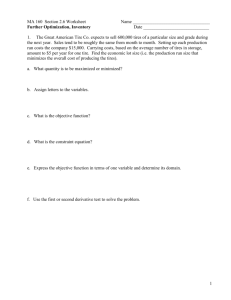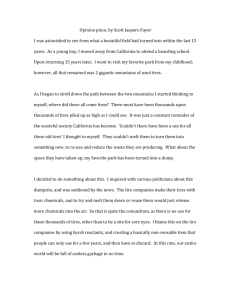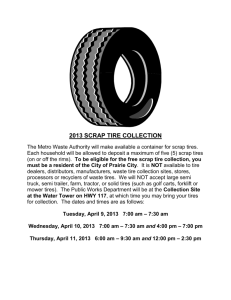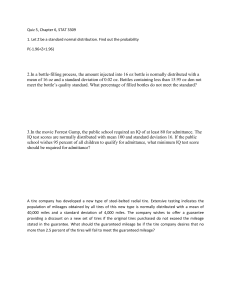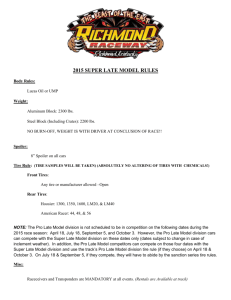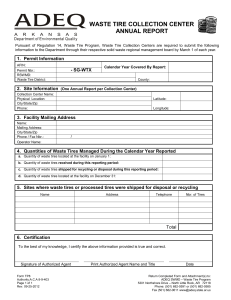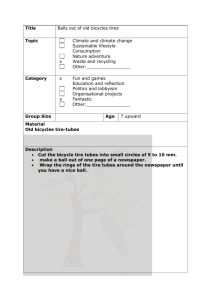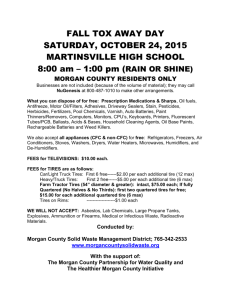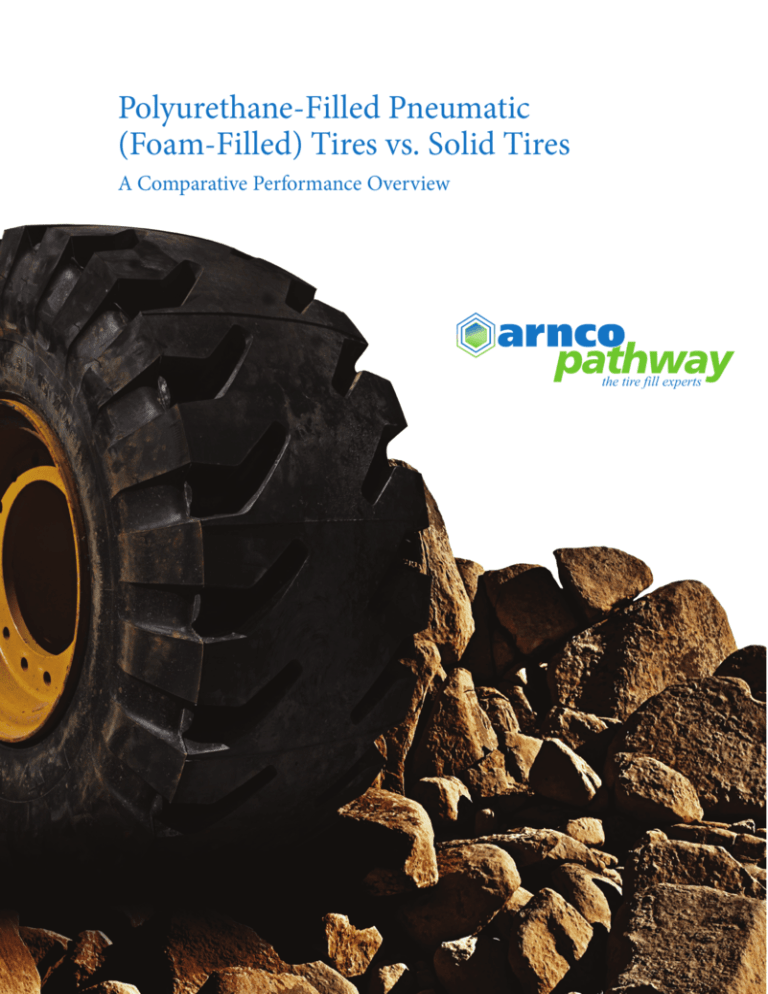
Polyurethane-Filled Pneumatic
(Foam-Filled) Tires vs. Solid Tires
A Comparative Performance Overview
pathway
the tire fill experts
Contents
Introduction.................................................................................. 1
History........................................................................................... 1
Comparative Overview................................................................ 1
Cushioning, Floatation & Shock Resistance............................. 1
Stability.......................................................................................... 2
Wear, Abrasion & Durability...................................................... 2
Traction.......................................................................................... 3
Cost................................................................................................ 3
Tire Performance Comparison by Application Type............... 4
Summary....................................................................................... 5
pathway
the tire fill experts
Introduction
The benefits and value propositions of polyurethane-filled pneumatic tires (commonly referred to as foam-filled
tires) and solid tires have been debated many times over the past few years by original equipment manufacturers
(OEMs), aftermarket customers, rental companies and tire dealers. It is important to understand that there is a
market for both products, but it is difficult to directly compare the two. Each flatproofing solution has strengths
and weaknesses, and determining the best option is dependent upon the application. Each product will function
effectively as long as it is installed correctly and used according to the manufacturer’s instructions. The greatest
advantage of polyurethane-filled pneumatic tires over solid tires is the availability of many combinations of
tire sizes, tread patterns, polyurethane fill durometers and inflation pressures for the operator to choose from
and customize according to each application. It is very difficult for solid tires to compete against this variety of
options.
History
Solid rubber tires were first used with heavy equipment in 1868 by Robert Thomson.1 Polyurethane tires were
first used during World War II, when German scientist Otto Bayer created polyurethane as a replacement for
expensive rubber.2 It was not until 1971, when the company that is now ArncoPathway invented tire fill (under
the brand name TyrFil®), that polyurethane became widely used as a flatproofing solution. This polyurethane tire
fill material has seen many further developments and improvements since then, including the development of
the AutoFil Recycling System® that recycles 100 percent of the TyrFil recovered from used tires. This continuous
improvement of tire fill and the tire fill process has allowed polyurethane filling to maintain its position as the
best value proposition for flatproofing tires. This value is the reason that most tire customers continue choosing
polyurethane-filled pneumatic tires for their flatproofing needs.
Comparative Overview
Cushioning, Floatation & Shock Resistance
A significant indication of the cushioning ability of any polyurethane-filled or solid tire is the durometer, or
hardness of the tread rubber and the material that fills the core. A solid or polyurethane-filled tire with a high
durometer is harder and absorbs less impact. A tire with a low durometer core is softer and absorbs more
impact. Solid rubber tires typically have a tread durometer of 65 and higher, with a slightly softer core. Many
solid tires have added aperture holes to produce increased cushioning. Polyurethane-filled pneumatic tires, on
the other hand, offer a wider range of core durometers from 8 to 55, allowing the customer to tailor the stiffness
of the tire for the application. Additionally, the pressure the polyurethane fill is installed at can be specified
to match the application requirements. Thus, polyurethane-filled pneumatic tires provide the operator many
options to modify the stiffness of the tire for a more comfortable ride where desired or less deflection where
stability is more important. Solid tires, in contrast, offer a limited choice of stiffness.
Softer tires absorb more vibration, reducing driver fatigue. Construction and mining machine operators seek
as smooth a ride as possible. These operators often prefer polyurethane-filled tires as the comfort and handling
characteristics of polyurethane-filled tires are more comparable to those of air-filled tires. Again, polyurethanefilled tires allow for more versatility of use because the core durometer and inflation pressure of each individual
tire can be controlled. Because tire fill is available in a variety of durometers, it provides each piece of equipment
with the operating characteristics appropriate for each application.
1 http://www.itec-tireshow.com/history/The%20first%20pneumatic%20tire.pdf
2 http://www.polyurethanes.org/index.php?page=history
1
pathway
the tire fill experts
Stability
The stability of a solid or polyurethane-filled tire is dependent on tire construction, tread pattern and stiffness.
Solid tires do not offer selection of rubber core alternatives, resulting in a very limited selection of tire stiffness.
The available tread patterns of solid tires are also very limited. On the other hand, pneumatic tires offer a much
wider variety of rubber compounds, tread patterns and stiffness. This flexibility is an advantage that allows the
operator to tailor the polyurethane fill in pneumatic tires to each specific application.
Another stability factor to be considered is the density of a tire. Filling a pneumatic tire with polyurethane adds
weight and stability to equipment. Rubber is more dense than polyurethane, resulting in added weight and
stability. However, a customer must consider that extra weight may be tougher on equipment. The added stability
from additional weight may put stress on hubs and wheel bearings, so additional maintenance may be required.
Wear, Abrasion & Durability
The life of a tire depends on many factors, including the application in which the tire is used, the quality of
the tire and whether the tire is used according to the manufacturer’s specifications. Solid tires generally have
deeper treads and can wear longer than polyurethane-filled tires in the right application. However, the larger
variety of tread patterns, sidewall construction and rubber formulation of polyurethane-filled pneumatic
tires allow the customer to customize the tire and fill for specific applications and soil conditions. This
customization maximizes traction, comfort and tread life, resulting in increased value. When the tread is worn
on a polyurethane-filled tire, but the carcass is still functional, the tire can be retreaded. ArncoPathway’ tests
with retreaders has demonstrated that there is no degradation in the polyurethane fill even after four retreading
cycles. If the carcass is damaged, an ArncoPathway dealer with an AutoFil Recycling System can recover the
polyurethane fill and recycle it.
Some believe that solids are better suited for scrap metal recycling facilities, demolition sites and
any application where sidewall damage may occur. However, Corrie DeVilliers with Cool Ideas in
Johannesburg, South Africa, has tested both solid and polyurethane-filled pneumatic tires, and has found
that using heavy-ply pneumatic tires filled with polyurethane in these applications provides a better value.
Corrie DeVilliers, with Cool Ideas, prefers using a heavy-ply pneumatic tire with foam fill in loaders at Power Metal Recyclers (PTY) LTD. in their
metal recycling facility near Johannesburg, South Africa.
2
pathway
the tire fill experts
Traction
Another difference between solid and polyurethane-filled tires is found in the traction of the tire, which refers
to the maximum frictional force that can be produced between the tire and the surface without slipping.3 Due to
the wide range of tread patterns, rubber compounds and polyurethane hardness, polyurethane-filled tires have
better traction over a wider variety of surfaces and terrain.
Cost
Tires are one of the most expensive maintenance and repair costs on an industrial vehicle. Both solid and
polyurethane-filled tires eliminate downtime, thereby reducing costs associated with tire repair. From a pricing
standpoint it is difficult to precisely compare the two types of tires as there are many variables to be considered.
The initial price paid for tires is generally higher for solids than for polyurethane-filled tires because solid tires
require specially designed wheels, as well as special mounting equipment. The replacement costs and availability
of these specially designed wheels and mounting equipment should be evaluated when considering total cost.
Current aftermarket price analyses show a typical 14.00 X 24.00 solid tire is approximately 60-200% more expensive
than a polyurethane-filled tire. Therefore, a solid tire must last at least twice as long to approach the cost savings
of a polyurethane-filled tire. (Keep in mind that solid, pneumatic and polyurethane-filled tires are all available in
varying grades of quality and durability. The aforementioned comparison was done using similar tire grades for both
products.)
As with any product, price is only one variable in the value equation. Dealers may purchase a solid tire at an
extremely low price, expecting a high return, only to realize that it must be replaced after only a couple hundred
hours of use. Similarly, equipment that comes directly from an OEM may have inexpensive polyurethane-filled
pneumatic tires that may only last several hundred hours on tough surfaces. However, many tire dealers state
that when those tires are replaced with high quality pneumatic tires filled with tire fill, they can last four or more
years.
Furthermore, several rental customers state that polyurethane-filled tires provide the lowest cost per hour
compared to solids. The rental fees that companies charge for similar machines are the same, regardless of
whether the tires on the machine are solid or polyurethane-filled. Since polyurethane-filled tires are less
expensive to buy and maintain, rental companies reap higher profits from rental equipment with polyurethanefilled tires.
Lastly, disposal costs must also be considered:
1. Polyurethane-filled tires can be retreaded for extra life.
2. Polyurethane-filled tire carcasses can be recycled after a long, useful life.
3. The tire fill inside a used polyurethane-filled tire can be recycled by a local tire dealer through the utilization
of a tire fill recycling system, whereas solid tires almost always end up in landfills.
3 http://dictionary.reference.com/browse/traction?s=t
3
pathway
the tire fill experts
Tire Performance Comparison by Application Type
Based on Customer Survey
Solid Tires
Mining
Agriculture
Construction
Forestry
Material Handling
Scrap Metal
Ground
Support
Scrap Metal
Ground
Support
Cushioning,
Floatation &
Shock
Resistance
Stability
Wear, Abrasion & Durability
Traction
Polyurethane-Filled Pneumatic Tires
Mining
Agriculture
Construction
Forestry
Material Handling
Cushioning,
Floatation &
Shock
Resistance
Stability
Wear, Abrasion & Durability
Traction
= BEST IN CLASS
4
= AVERAGE
= WORST IN CLASS
pathway
the tire fill experts
Summary
To summarize the text and comparison chart on the previous page, each application requires a specific tread,
durometer and stiffness of tire. While solid tires perform well in certain applications, polyurethane-filled
pneumatic tires allow the most flexibility, thereby providing the best value proposition for most applications.
“The performance of the entire machine and the operator is dependent on many factors,” agrees J.P. Gallagher,
of Gallagher Tire, who has been foam filling for over 20 years. “We feel that a foam-filled tire provides the
best option to cover the many different areas where these machines operate. We are confident that the tire fill
solution is the best option for most machines that cannot afford downtime.” Stuart LaPerle with Preventative Tire
Maintenance Group Inc., says that based on his 35 years of experience filling tires, “There is no doubt that solid
tires can be effective in certain applications, but polyurethane-filled tires provide the most return for every dollar
invested, allowing the operator to utilize the tire for more hours at a lower cost.” Polyurethane-filled tires are the
best flatproofing solution available because they provide better cushioning, stability and traction, as well as the
lowest cost and highest return on investment over the life of the tire.
Any of our highly trained TyrFil dealers can assist you in selecting the best value flatproofing solution for your
application. If you are not familiar with a TyrFil dealer in your area, contact ArncoPathway Customer Service at
800.821.4147.
5
pathway
the tire fill experts
ArncoPathway is the inventor and manufacturer of TyrFil®, the world’s first polyurethane tire
fill product. A global technology leader in the tire flat proofing industry, ArncoPathway is the
exclusive provider of TyrFil®.
Find more information at www.tyrfil.com or call 800.821.4147.
Copyright © 2012. All rights reserved.
Printed April 2014 Revision 2


